Factors Shaping Crisis Management
VerifiedAdded on 2022/09/02
|16
|5347
|26
AI Summary
Contribute Materials
Your contribution can guide someone’s learning journey. Share your
documents today.
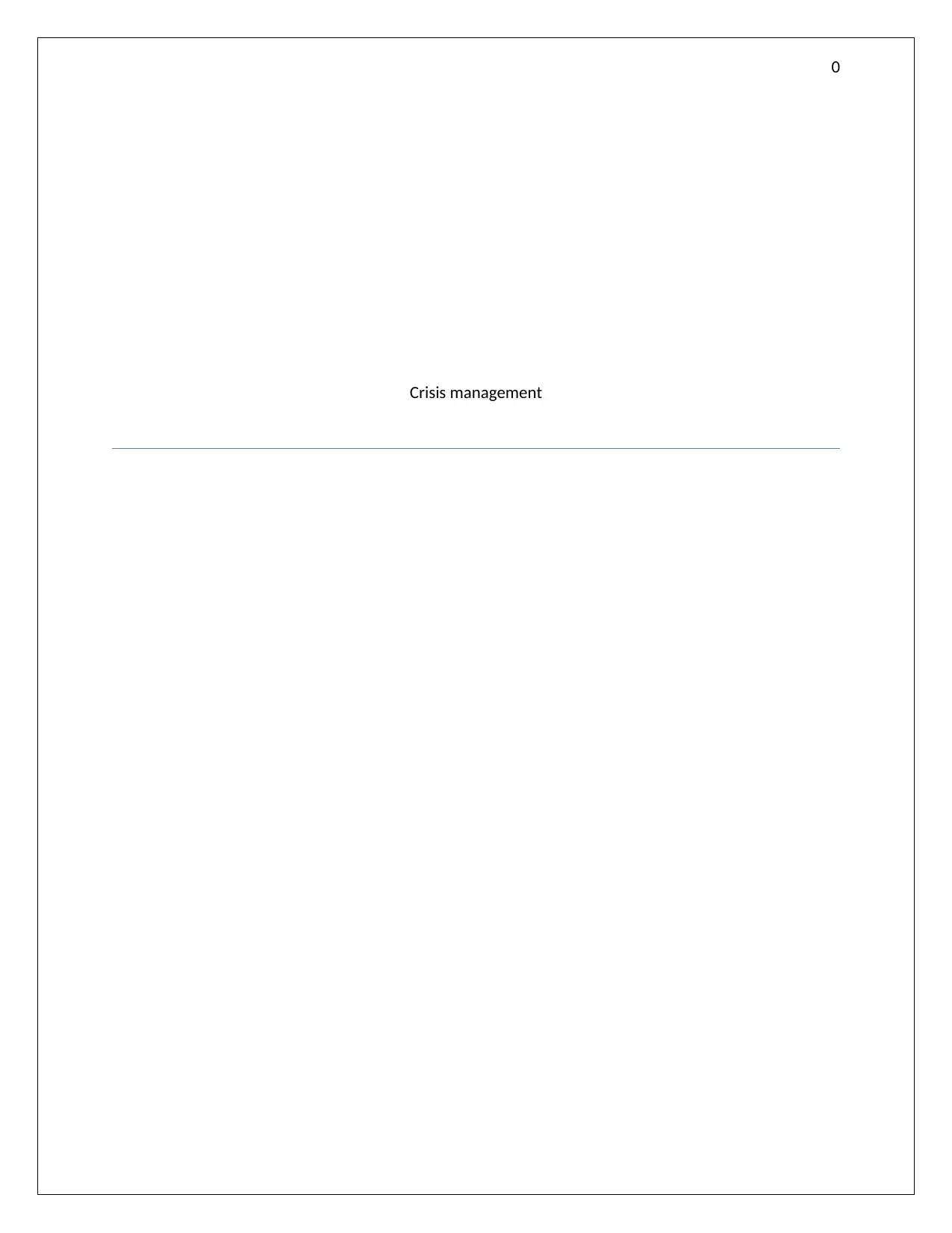
0
Crisis management
Crisis management
Secure Best Marks with AI Grader
Need help grading? Try our AI Grader for instant feedback on your assignments.
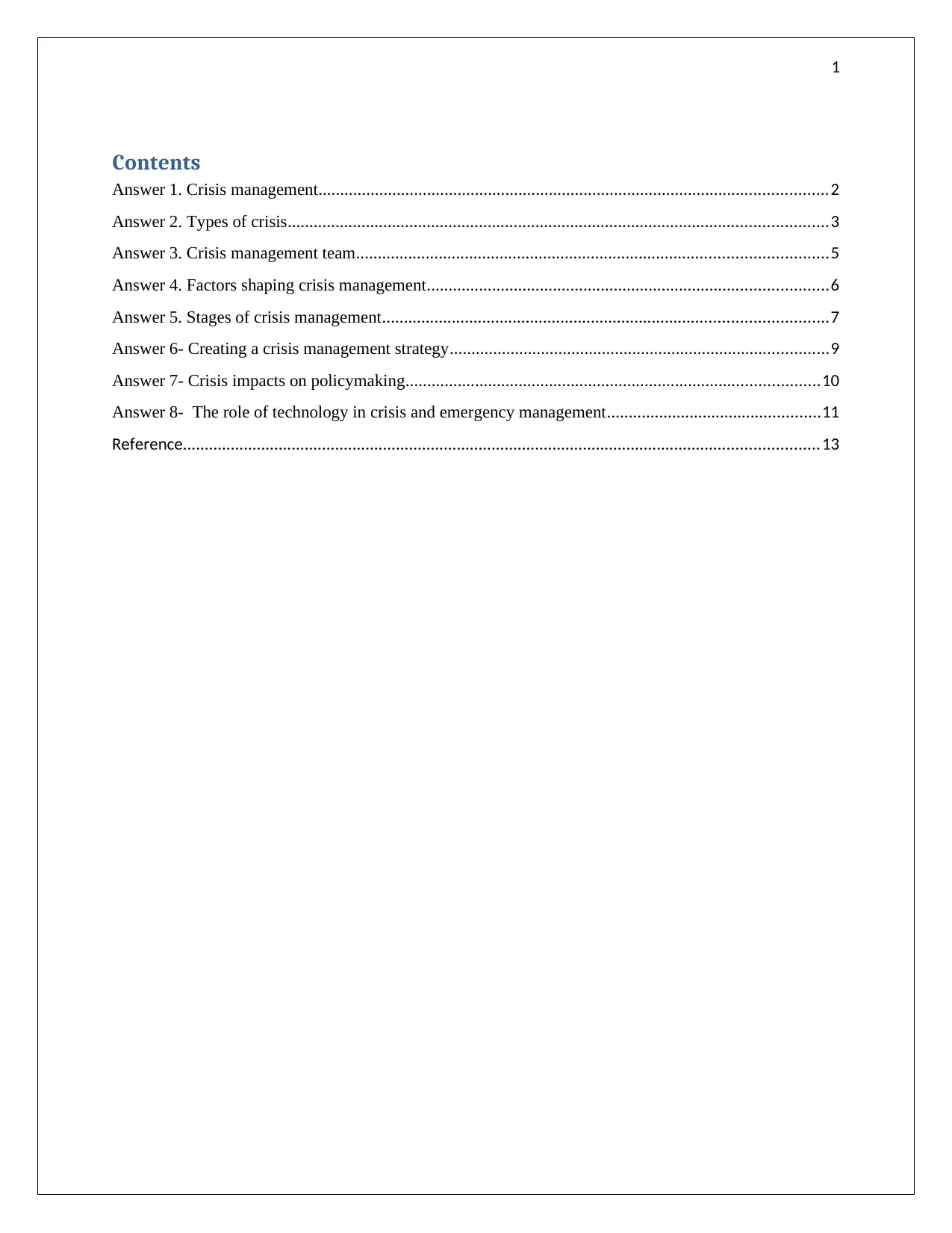
1
Contents
Answer 1. Crisis management.....................................................................................................................2
Answer 2. Types of crisis............................................................................................................................3
Answer 3. Crisis management team............................................................................................................5
Answer 4. Factors shaping crisis management............................................................................................6
Answer 5. Stages of crisis management......................................................................................................7
Answer 6- Creating a crisis management strategy.......................................................................................9
Answer 7- Crisis impacts on policymaking...............................................................................................10
Answer 8- The role of technology in crisis and emergency management.................................................11
Reference..................................................................................................................................................13
Contents
Answer 1. Crisis management.....................................................................................................................2
Answer 2. Types of crisis............................................................................................................................3
Answer 3. Crisis management team............................................................................................................5
Answer 4. Factors shaping crisis management............................................................................................6
Answer 5. Stages of crisis management......................................................................................................7
Answer 6- Creating a crisis management strategy.......................................................................................9
Answer 7- Crisis impacts on policymaking...............................................................................................10
Answer 8- The role of technology in crisis and emergency management.................................................11
Reference..................................................................................................................................................13
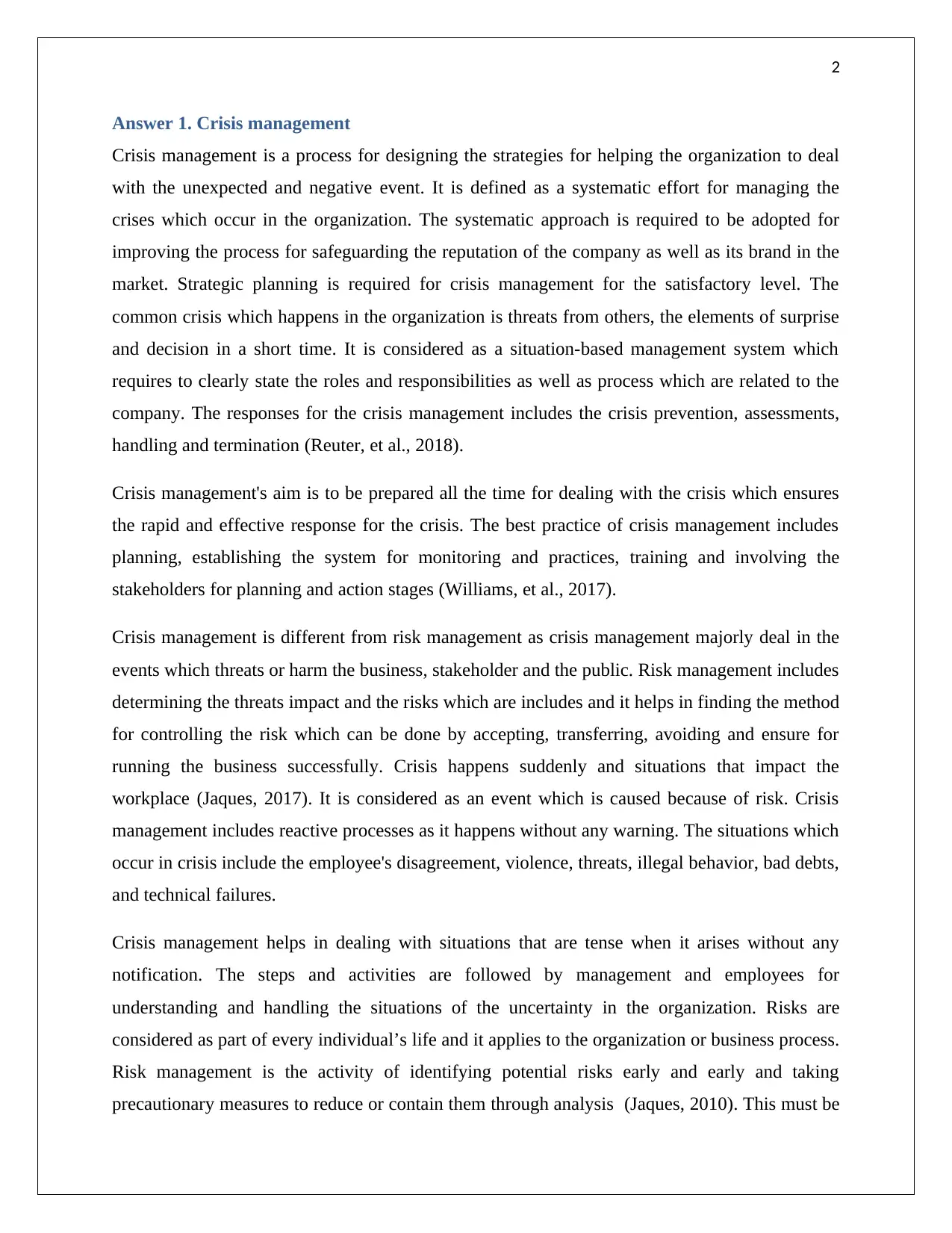
2
Answer 1. Crisis management
Crisis management is a process for designing the strategies for helping the organization to deal
with the unexpected and negative event. It is defined as a systematic effort for managing the
crises which occur in the organization. The systematic approach is required to be adopted for
improving the process for safeguarding the reputation of the company as well as its brand in the
market. Strategic planning is required for crisis management for the satisfactory level. The
common crisis which happens in the organization is threats from others, the elements of surprise
and decision in a short time. It is considered as a situation-based management system which
requires to clearly state the roles and responsibilities as well as process which are related to the
company. The responses for the crisis management includes the crisis prevention, assessments,
handling and termination (Reuter, et al., 2018).
Crisis management's aim is to be prepared all the time for dealing with the crisis which ensures
the rapid and effective response for the crisis. The best practice of crisis management includes
planning, establishing the system for monitoring and practices, training and involving the
stakeholders for planning and action stages (Williams, et al., 2017).
Crisis management is different from risk management as crisis management majorly deal in the
events which threats or harm the business, stakeholder and the public. Risk management includes
determining the threats impact and the risks which are includes and it helps in finding the method
for controlling the risk which can be done by accepting, transferring, avoiding and ensure for
running the business successfully. Crisis happens suddenly and situations that impact the
workplace (Jaques, 2017). It is considered as an event which is caused because of risk. Crisis
management includes reactive processes as it happens without any warning. The situations which
occur in crisis include the employee's disagreement, violence, threats, illegal behavior, bad debts,
and technical failures.
Crisis management helps in dealing with situations that are tense when it arises without any
notification. The steps and activities are followed by management and employees for
understanding and handling the situations of the uncertainty in the organization. Risks are
considered as part of every individual’s life and it applies to the organization or business process.
Risk management is the activity of identifying potential risks early and early and taking
precautionary measures to reduce or contain them through analysis (Jaques, 2010). This must be
Answer 1. Crisis management
Crisis management is a process for designing the strategies for helping the organization to deal
with the unexpected and negative event. It is defined as a systematic effort for managing the
crises which occur in the organization. The systematic approach is required to be adopted for
improving the process for safeguarding the reputation of the company as well as its brand in the
market. Strategic planning is required for crisis management for the satisfactory level. The
common crisis which happens in the organization is threats from others, the elements of surprise
and decision in a short time. It is considered as a situation-based management system which
requires to clearly state the roles and responsibilities as well as process which are related to the
company. The responses for the crisis management includes the crisis prevention, assessments,
handling and termination (Reuter, et al., 2018).
Crisis management's aim is to be prepared all the time for dealing with the crisis which ensures
the rapid and effective response for the crisis. The best practice of crisis management includes
planning, establishing the system for monitoring and practices, training and involving the
stakeholders for planning and action stages (Williams, et al., 2017).
Crisis management is different from risk management as crisis management majorly deal in the
events which threats or harm the business, stakeholder and the public. Risk management includes
determining the threats impact and the risks which are includes and it helps in finding the method
for controlling the risk which can be done by accepting, transferring, avoiding and ensure for
running the business successfully. Crisis happens suddenly and situations that impact the
workplace (Jaques, 2017). It is considered as an event which is caused because of risk. Crisis
management includes reactive processes as it happens without any warning. The situations which
occur in crisis include the employee's disagreement, violence, threats, illegal behavior, bad debts,
and technical failures.
Crisis management helps in dealing with situations that are tense when it arises without any
notification. The steps and activities are followed by management and employees for
understanding and handling the situations of the uncertainty in the organization. Risks are
considered as part of every individual’s life and it applies to the organization or business process.
Risk management is the activity of identifying potential risks early and early and taking
precautionary measures to reduce or contain them through analysis (Jaques, 2010). This must be
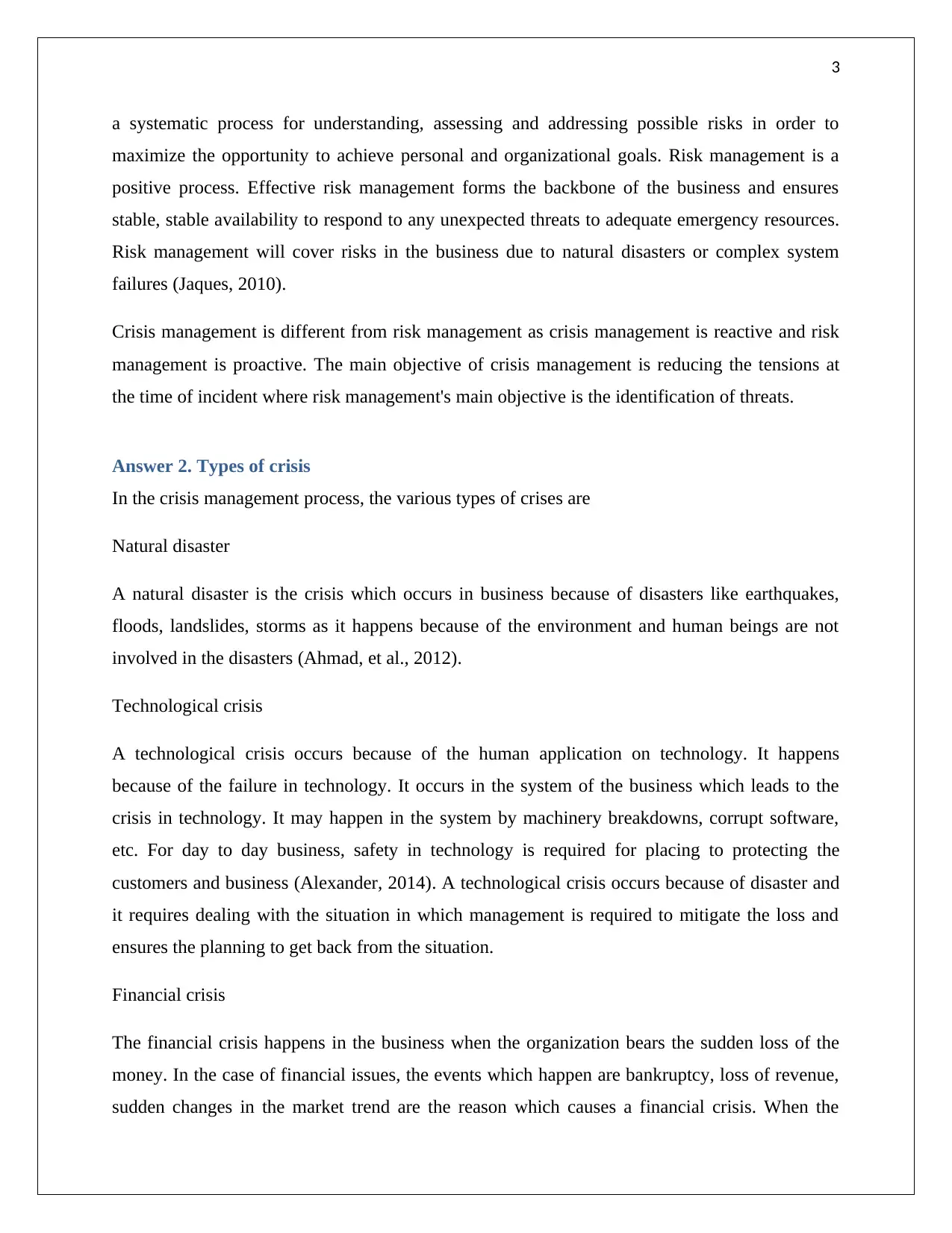
3
a systematic process for understanding, assessing and addressing possible risks in order to
maximize the opportunity to achieve personal and organizational goals. Risk management is a
positive process. Effective risk management forms the backbone of the business and ensures
stable, stable availability to respond to any unexpected threats to adequate emergency resources.
Risk management will cover risks in the business due to natural disasters or complex system
failures (Jaques, 2010).
Crisis management is different from risk management as crisis management is reactive and risk
management is proactive. The main objective of crisis management is reducing the tensions at
the time of incident where risk management's main objective is the identification of threats.
Answer 2. Types of crisis
In the crisis management process, the various types of crises are
Natural disaster
A natural disaster is the crisis which occurs in business because of disasters like earthquakes,
floods, landslides, storms as it happens because of the environment and human beings are not
involved in the disasters (Ahmad, et al., 2012).
Technological crisis
A technological crisis occurs because of the human application on technology. It happens
because of the failure in technology. It occurs in the system of the business which leads to the
crisis in technology. It may happen in the system by machinery breakdowns, corrupt software,
etc. For day to day business, safety in technology is required for placing to protecting the
customers and business (Alexander, 2014). A technological crisis occurs because of disaster and
it requires dealing with the situation in which management is required to mitigate the loss and
ensures the planning to get back from the situation.
Financial crisis
The financial crisis happens in the business when the organization bears the sudden loss of the
money. In the case of financial issues, the events which happen are bankruptcy, loss of revenue,
sudden changes in the market trend are the reason which causes a financial crisis. When the
a systematic process for understanding, assessing and addressing possible risks in order to
maximize the opportunity to achieve personal and organizational goals. Risk management is a
positive process. Effective risk management forms the backbone of the business and ensures
stable, stable availability to respond to any unexpected threats to adequate emergency resources.
Risk management will cover risks in the business due to natural disasters or complex system
failures (Jaques, 2010).
Crisis management is different from risk management as crisis management is reactive and risk
management is proactive. The main objective of crisis management is reducing the tensions at
the time of incident where risk management's main objective is the identification of threats.
Answer 2. Types of crisis
In the crisis management process, the various types of crises are
Natural disaster
A natural disaster is the crisis which occurs in business because of disasters like earthquakes,
floods, landslides, storms as it happens because of the environment and human beings are not
involved in the disasters (Ahmad, et al., 2012).
Technological crisis
A technological crisis occurs because of the human application on technology. It happens
because of the failure in technology. It occurs in the system of the business which leads to the
crisis in technology. It may happen in the system by machinery breakdowns, corrupt software,
etc. For day to day business, safety in technology is required for placing to protecting the
customers and business (Alexander, 2014). A technological crisis occurs because of disaster and
it requires dealing with the situation in which management is required to mitigate the loss and
ensures the planning to get back from the situation.
Financial crisis
The financial crisis happens in the business when the organization bears the sudden loss of the
money. In the case of financial issues, the events which happen are bankruptcy, loss of revenue,
sudden changes in the market trend are the reason which causes a financial crisis. When the
Secure Best Marks with AI Grader
Need help grading? Try our AI Grader for instant feedback on your assignments.
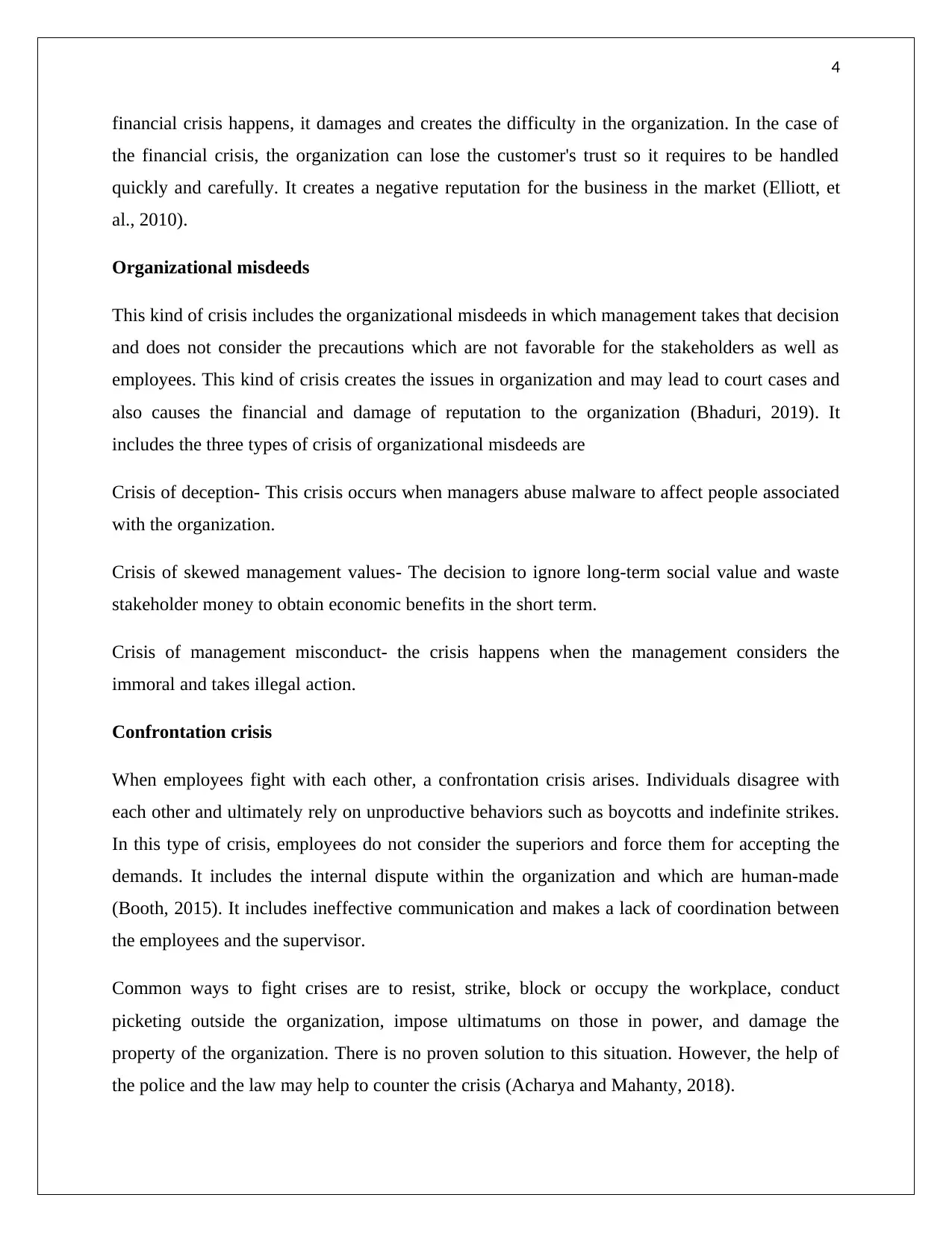
4
financial crisis happens, it damages and creates the difficulty in the organization. In the case of
the financial crisis, the organization can lose the customer's trust so it requires to be handled
quickly and carefully. It creates a negative reputation for the business in the market (Elliott, et
al., 2010).
Organizational misdeeds
This kind of crisis includes the organizational misdeeds in which management takes that decision
and does not consider the precautions which are not favorable for the stakeholders as well as
employees. This kind of crisis creates the issues in organization and may lead to court cases and
also causes the financial and damage of reputation to the organization (Bhaduri, 2019). It
includes the three types of crisis of organizational misdeeds are
Crisis of deception- This crisis occurs when managers abuse malware to affect people associated
with the organization.
Crisis of skewed management values- The decision to ignore long-term social value and waste
stakeholder money to obtain economic benefits in the short term.
Crisis of management misconduct- the crisis happens when the management considers the
immoral and takes illegal action.
Confrontation crisis
When employees fight with each other, a confrontation crisis arises. Individuals disagree with
each other and ultimately rely on unproductive behaviors such as boycotts and indefinite strikes.
In this type of crisis, employees do not consider the superiors and force them for accepting the
demands. It includes the internal dispute within the organization and which are human-made
(Booth, 2015). It includes ineffective communication and makes a lack of coordination between
the employees and the supervisor.
Common ways to fight crises are to resist, strike, block or occupy the workplace, conduct
picketing outside the organization, impose ultimatums on those in power, and damage the
property of the organization. There is no proven solution to this situation. However, the help of
the police and the law may help to counter the crisis (Acharya and Mahanty, 2018).
financial crisis happens, it damages and creates the difficulty in the organization. In the case of
the financial crisis, the organization can lose the customer's trust so it requires to be handled
quickly and carefully. It creates a negative reputation for the business in the market (Elliott, et
al., 2010).
Organizational misdeeds
This kind of crisis includes the organizational misdeeds in which management takes that decision
and does not consider the precautions which are not favorable for the stakeholders as well as
employees. This kind of crisis creates the issues in organization and may lead to court cases and
also causes the financial and damage of reputation to the organization (Bhaduri, 2019). It
includes the three types of crisis of organizational misdeeds are
Crisis of deception- This crisis occurs when managers abuse malware to affect people associated
with the organization.
Crisis of skewed management values- The decision to ignore long-term social value and waste
stakeholder money to obtain economic benefits in the short term.
Crisis of management misconduct- the crisis happens when the management considers the
immoral and takes illegal action.
Confrontation crisis
When employees fight with each other, a confrontation crisis arises. Individuals disagree with
each other and ultimately rely on unproductive behaviors such as boycotts and indefinite strikes.
In this type of crisis, employees do not consider the superiors and force them for accepting the
demands. It includes the internal dispute within the organization and which are human-made
(Booth, 2015). It includes ineffective communication and makes a lack of coordination between
the employees and the supervisor.
Common ways to fight crises are to resist, strike, block or occupy the workplace, conduct
picketing outside the organization, impose ultimatums on those in power, and damage the
property of the organization. There is no proven solution to this situation. However, the help of
the police and the law may help to counter the crisis (Acharya and Mahanty, 2018).
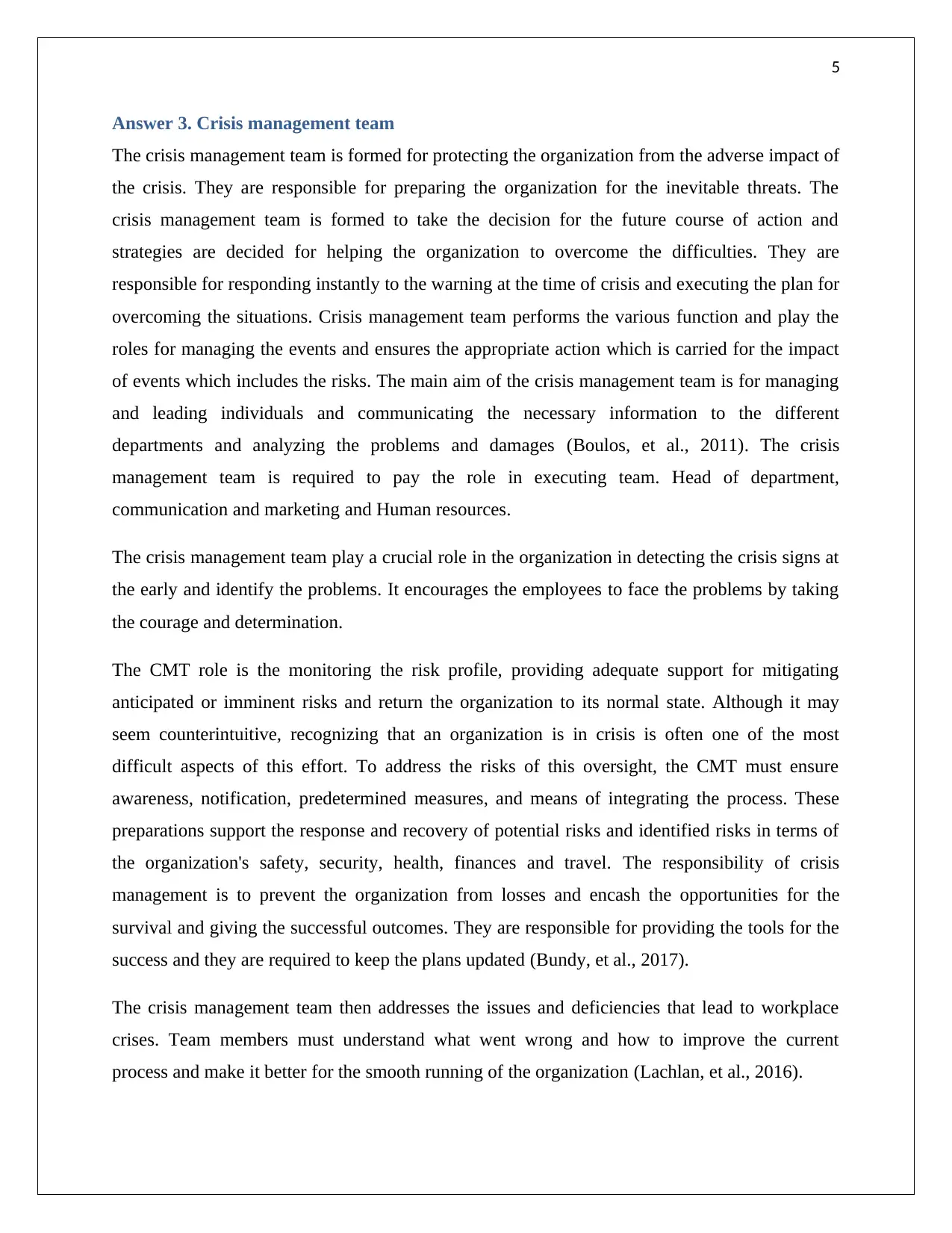
5
Answer 3. Crisis management team
The crisis management team is formed for protecting the organization from the adverse impact of
the crisis. They are responsible for preparing the organization for the inevitable threats. The
crisis management team is formed to take the decision for the future course of action and
strategies are decided for helping the organization to overcome the difficulties. They are
responsible for responding instantly to the warning at the time of crisis and executing the plan for
overcoming the situations. Crisis management team performs the various function and play the
roles for managing the events and ensures the appropriate action which is carried for the impact
of events which includes the risks. The main aim of the crisis management team is for managing
and leading individuals and communicating the necessary information to the different
departments and analyzing the problems and damages (Boulos, et al., 2011). The crisis
management team is required to pay the role in executing team. Head of department,
communication and marketing and Human resources.
The crisis management team play a crucial role in the organization in detecting the crisis signs at
the early and identify the problems. It encourages the employees to face the problems by taking
the courage and determination.
The CMT role is the monitoring the risk profile, providing adequate support for mitigating
anticipated or imminent risks and return the organization to its normal state. Although it may
seem counterintuitive, recognizing that an organization is in crisis is often one of the most
difficult aspects of this effort. To address the risks of this oversight, the CMT must ensure
awareness, notification, predetermined measures, and means of integrating the process. These
preparations support the response and recovery of potential risks and identified risks in terms of
the organization's safety, security, health, finances and travel. The responsibility of crisis
management is to prevent the organization from losses and encash the opportunities for the
survival and giving the successful outcomes. They are responsible for providing the tools for the
success and they are required to keep the plans updated (Bundy, et al., 2017).
The crisis management team then addresses the issues and deficiencies that lead to workplace
crises. Team members must understand what went wrong and how to improve the current
process and make it better for the smooth running of the organization (Lachlan, et al., 2016).
Answer 3. Crisis management team
The crisis management team is formed for protecting the organization from the adverse impact of
the crisis. They are responsible for preparing the organization for the inevitable threats. The
crisis management team is formed to take the decision for the future course of action and
strategies are decided for helping the organization to overcome the difficulties. They are
responsible for responding instantly to the warning at the time of crisis and executing the plan for
overcoming the situations. Crisis management team performs the various function and play the
roles for managing the events and ensures the appropriate action which is carried for the impact
of events which includes the risks. The main aim of the crisis management team is for managing
and leading individuals and communicating the necessary information to the different
departments and analyzing the problems and damages (Boulos, et al., 2011). The crisis
management team is required to pay the role in executing team. Head of department,
communication and marketing and Human resources.
The crisis management team play a crucial role in the organization in detecting the crisis signs at
the early and identify the problems. It encourages the employees to face the problems by taking
the courage and determination.
The CMT role is the monitoring the risk profile, providing adequate support for mitigating
anticipated or imminent risks and return the organization to its normal state. Although it may
seem counterintuitive, recognizing that an organization is in crisis is often one of the most
difficult aspects of this effort. To address the risks of this oversight, the CMT must ensure
awareness, notification, predetermined measures, and means of integrating the process. These
preparations support the response and recovery of potential risks and identified risks in terms of
the organization's safety, security, health, finances and travel. The responsibility of crisis
management is to prevent the organization from losses and encash the opportunities for the
survival and giving the successful outcomes. They are responsible for providing the tools for the
success and they are required to keep the plans updated (Bundy, et al., 2017).
The crisis management team then addresses the issues and deficiencies that lead to workplace
crises. Team members must understand what went wrong and how to improve the current
process and make it better for the smooth running of the organization (Lachlan, et al., 2016).
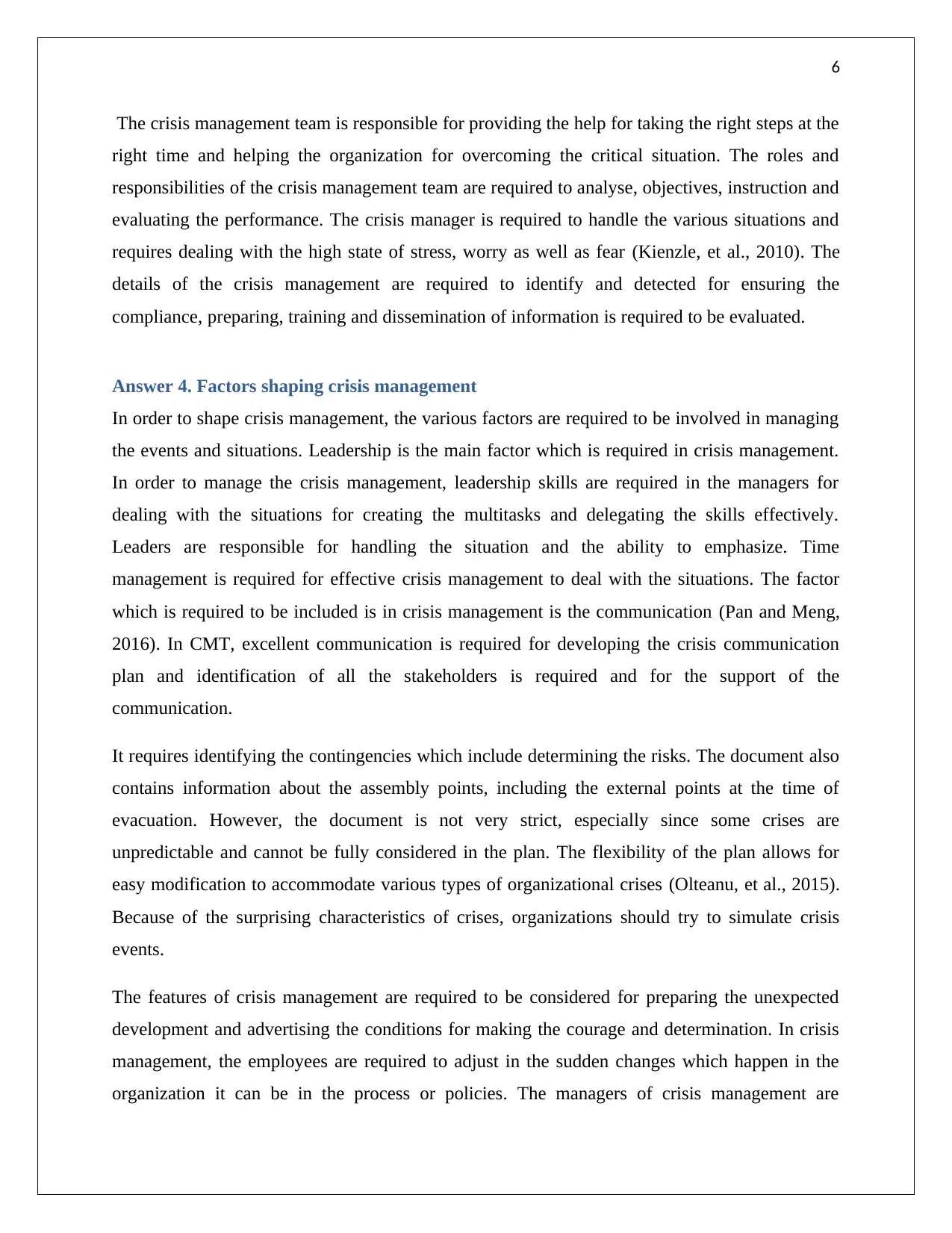
6
The crisis management team is responsible for providing the help for taking the right steps at the
right time and helping the organization for overcoming the critical situation. The roles and
responsibilities of the crisis management team are required to analyse, objectives, instruction and
evaluating the performance. The crisis manager is required to handle the various situations and
requires dealing with the high state of stress, worry as well as fear (Kienzle, et al., 2010). The
details of the crisis management are required to identify and detected for ensuring the
compliance, preparing, training and dissemination of information is required to be evaluated.
Answer 4. Factors shaping crisis management
In order to shape crisis management, the various factors are required to be involved in managing
the events and situations. Leadership is the main factor which is required in crisis management.
In order to manage the crisis management, leadership skills are required in the managers for
dealing with the situations for creating the multitasks and delegating the skills effectively.
Leaders are responsible for handling the situation and the ability to emphasize. Time
management is required for effective crisis management to deal with the situations. The factor
which is required to be included is in crisis management is the communication (Pan and Meng,
2016). In CMT, excellent communication is required for developing the crisis communication
plan and identification of all the stakeholders is required and for the support of the
communication.
It requires identifying the contingencies which include determining the risks. The document also
contains information about the assembly points, including the external points at the time of
evacuation. However, the document is not very strict, especially since some crises are
unpredictable and cannot be fully considered in the plan. The flexibility of the plan allows for
easy modification to accommodate various types of organizational crises (Olteanu, et al., 2015).
Because of the surprising characteristics of crises, organizations should try to simulate crisis
events.
The features of crisis management are required to be considered for preparing the unexpected
development and advertising the conditions for making the courage and determination. In crisis
management, the employees are required to adjust in the sudden changes which happen in the
organization it can be in the process or policies. The managers of crisis management are
The crisis management team is responsible for providing the help for taking the right steps at the
right time and helping the organization for overcoming the critical situation. The roles and
responsibilities of the crisis management team are required to analyse, objectives, instruction and
evaluating the performance. The crisis manager is required to handle the various situations and
requires dealing with the high state of stress, worry as well as fear (Kienzle, et al., 2010). The
details of the crisis management are required to identify and detected for ensuring the
compliance, preparing, training and dissemination of information is required to be evaluated.
Answer 4. Factors shaping crisis management
In order to shape crisis management, the various factors are required to be involved in managing
the events and situations. Leadership is the main factor which is required in crisis management.
In order to manage the crisis management, leadership skills are required in the managers for
dealing with the situations for creating the multitasks and delegating the skills effectively.
Leaders are responsible for handling the situation and the ability to emphasize. Time
management is required for effective crisis management to deal with the situations. The factor
which is required to be included is in crisis management is the communication (Pan and Meng,
2016). In CMT, excellent communication is required for developing the crisis communication
plan and identification of all the stakeholders is required and for the support of the
communication.
It requires identifying the contingencies which include determining the risks. The document also
contains information about the assembly points, including the external points at the time of
evacuation. However, the document is not very strict, especially since some crises are
unpredictable and cannot be fully considered in the plan. The flexibility of the plan allows for
easy modification to accommodate various types of organizational crises (Olteanu, et al., 2015).
Because of the surprising characteristics of crises, organizations should try to simulate crisis
events.
The features of crisis management are required to be considered for preparing the unexpected
development and advertising the conditions for making the courage and determination. In crisis
management, the employees are required to adjust in the sudden changes which happen in the
organization it can be in the process or policies. The managers of crisis management are
Paraphrase This Document
Need a fresh take? Get an instant paraphrase of this document with our AI Paraphraser
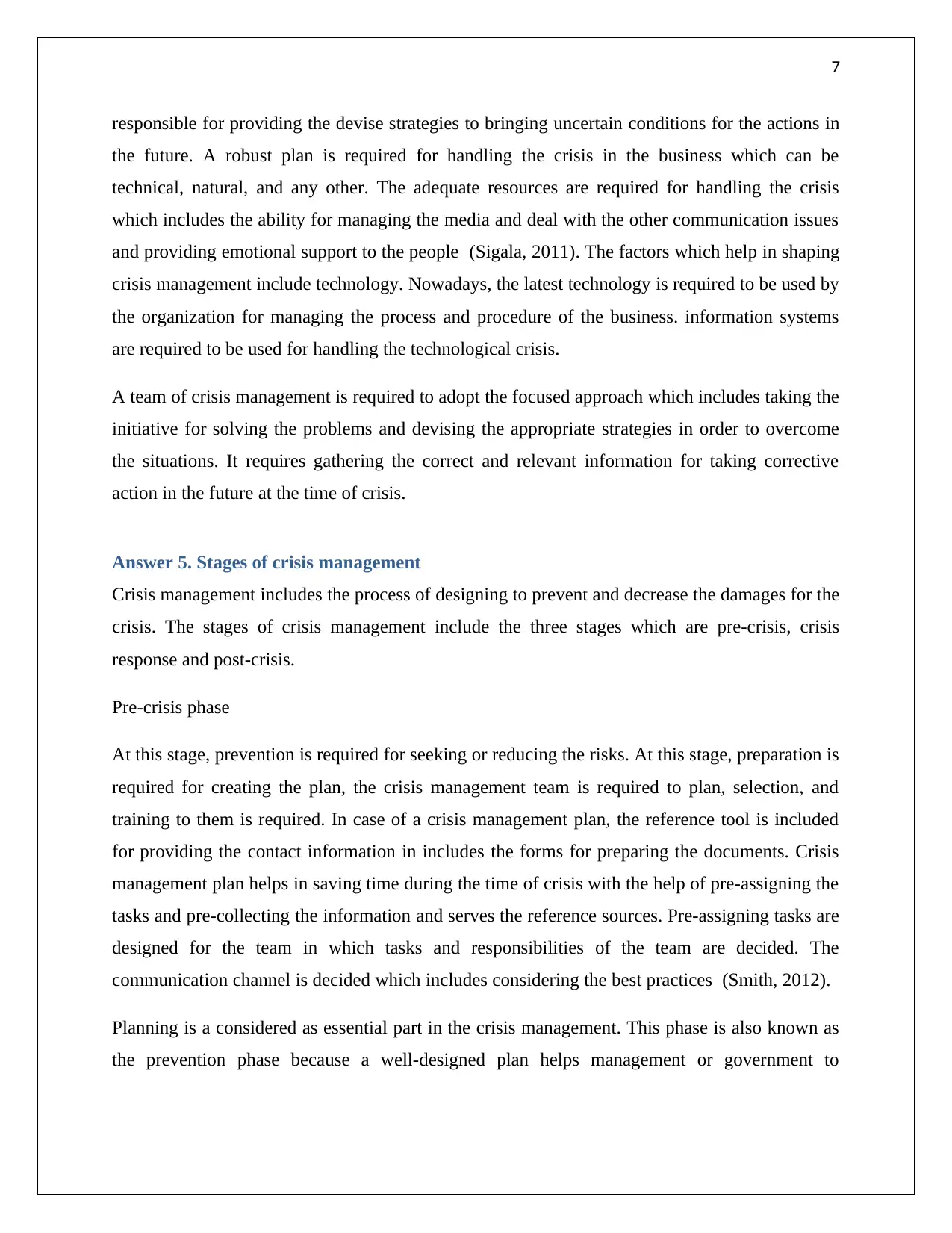
7
responsible for providing the devise strategies to bringing uncertain conditions for the actions in
the future. A robust plan is required for handling the crisis in the business which can be
technical, natural, and any other. The adequate resources are required for handling the crisis
which includes the ability for managing the media and deal with the other communication issues
and providing emotional support to the people (Sigala, 2011). The factors which help in shaping
crisis management include technology. Nowadays, the latest technology is required to be used by
the organization for managing the process and procedure of the business. information systems
are required to be used for handling the technological crisis.
A team of crisis management is required to adopt the focused approach which includes taking the
initiative for solving the problems and devising the appropriate strategies in order to overcome
the situations. It requires gathering the correct and relevant information for taking corrective
action in the future at the time of crisis.
Answer 5. Stages of crisis management
Crisis management includes the process of designing to prevent and decrease the damages for the
crisis. The stages of crisis management include the three stages which are pre-crisis, crisis
response and post-crisis.
Pre-crisis phase
At this stage, prevention is required for seeking or reducing the risks. At this stage, preparation is
required for creating the plan, the crisis management team is required to plan, selection, and
training to them is required. In case of a crisis management plan, the reference tool is included
for providing the contact information in includes the forms for preparing the documents. Crisis
management plan helps in saving time during the time of crisis with the help of pre-assigning the
tasks and pre-collecting the information and serves the reference sources. Pre-assigning tasks are
designed for the team in which tasks and responsibilities of the team are decided. The
communication channel is decided which includes considering the best practices (Smith, 2012).
Planning is a considered as essential part in the crisis management. This phase is also known as
the prevention phase because a well-designed plan helps management or government to
responsible for providing the devise strategies to bringing uncertain conditions for the actions in
the future. A robust plan is required for handling the crisis in the business which can be
technical, natural, and any other. The adequate resources are required for handling the crisis
which includes the ability for managing the media and deal with the other communication issues
and providing emotional support to the people (Sigala, 2011). The factors which help in shaping
crisis management include technology. Nowadays, the latest technology is required to be used by
the organization for managing the process and procedure of the business. information systems
are required to be used for handling the technological crisis.
A team of crisis management is required to adopt the focused approach which includes taking the
initiative for solving the problems and devising the appropriate strategies in order to overcome
the situations. It requires gathering the correct and relevant information for taking corrective
action in the future at the time of crisis.
Answer 5. Stages of crisis management
Crisis management includes the process of designing to prevent and decrease the damages for the
crisis. The stages of crisis management include the three stages which are pre-crisis, crisis
response and post-crisis.
Pre-crisis phase
At this stage, prevention is required for seeking or reducing the risks. At this stage, preparation is
required for creating the plan, the crisis management team is required to plan, selection, and
training to them is required. In case of a crisis management plan, the reference tool is included
for providing the contact information in includes the forms for preparing the documents. Crisis
management plan helps in saving time during the time of crisis with the help of pre-assigning the
tasks and pre-collecting the information and serves the reference sources. Pre-assigning tasks are
designed for the team in which tasks and responsibilities of the team are decided. The
communication channel is decided which includes considering the best practices (Smith, 2012).
Planning is a considered as essential part in the crisis management. This phase is also known as
the prevention phase because a well-designed plan helps management or government to
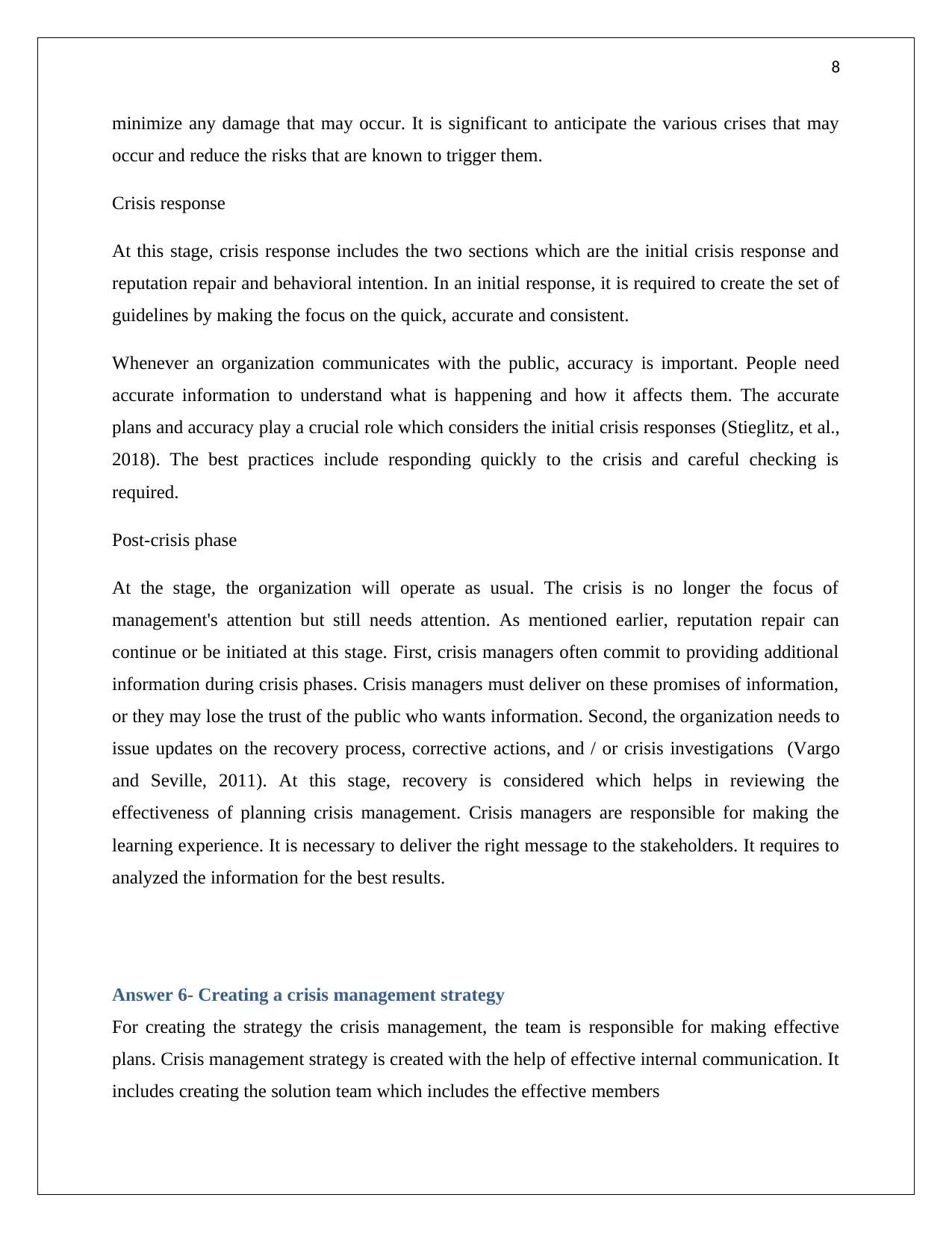
8
minimize any damage that may occur. It is significant to anticipate the various crises that may
occur and reduce the risks that are known to trigger them.
Crisis response
At this stage, crisis response includes the two sections which are the initial crisis response and
reputation repair and behavioral intention. In an initial response, it is required to create the set of
guidelines by making the focus on the quick, accurate and consistent.
Whenever an organization communicates with the public, accuracy is important. People need
accurate information to understand what is happening and how it affects them. The accurate
plans and accuracy play a crucial role which considers the initial crisis responses (Stieglitz, et al.,
2018). The best practices include responding quickly to the crisis and careful checking is
required.
Post-crisis phase
At the stage, the organization will operate as usual. The crisis is no longer the focus of
management's attention but still needs attention. As mentioned earlier, reputation repair can
continue or be initiated at this stage. First, crisis managers often commit to providing additional
information during crisis phases. Crisis managers must deliver on these promises of information,
or they may lose the trust of the public who wants information. Second, the organization needs to
issue updates on the recovery process, corrective actions, and / or crisis investigations (Vargo
and Seville, 2011). At this stage, recovery is considered which helps in reviewing the
effectiveness of planning crisis management. Crisis managers are responsible for making the
learning experience. It is necessary to deliver the right message to the stakeholders. It requires to
analyzed the information for the best results.
Answer 6- Creating a crisis management strategy
For creating the strategy the crisis management, the team is responsible for making effective
plans. Crisis management strategy is created with the help of effective internal communication. It
includes creating the solution team which includes the effective members
minimize any damage that may occur. It is significant to anticipate the various crises that may
occur and reduce the risks that are known to trigger them.
Crisis response
At this stage, crisis response includes the two sections which are the initial crisis response and
reputation repair and behavioral intention. In an initial response, it is required to create the set of
guidelines by making the focus on the quick, accurate and consistent.
Whenever an organization communicates with the public, accuracy is important. People need
accurate information to understand what is happening and how it affects them. The accurate
plans and accuracy play a crucial role which considers the initial crisis responses (Stieglitz, et al.,
2018). The best practices include responding quickly to the crisis and careful checking is
required.
Post-crisis phase
At the stage, the organization will operate as usual. The crisis is no longer the focus of
management's attention but still needs attention. As mentioned earlier, reputation repair can
continue or be initiated at this stage. First, crisis managers often commit to providing additional
information during crisis phases. Crisis managers must deliver on these promises of information,
or they may lose the trust of the public who wants information. Second, the organization needs to
issue updates on the recovery process, corrective actions, and / or crisis investigations (Vargo
and Seville, 2011). At this stage, recovery is considered which helps in reviewing the
effectiveness of planning crisis management. Crisis managers are responsible for making the
learning experience. It is necessary to deliver the right message to the stakeholders. It requires to
analyzed the information for the best results.
Answer 6- Creating a crisis management strategy
For creating the strategy the crisis management, the team is responsible for making effective
plans. Crisis management strategy is created with the help of effective internal communication. It
includes creating the solution team which includes the effective members
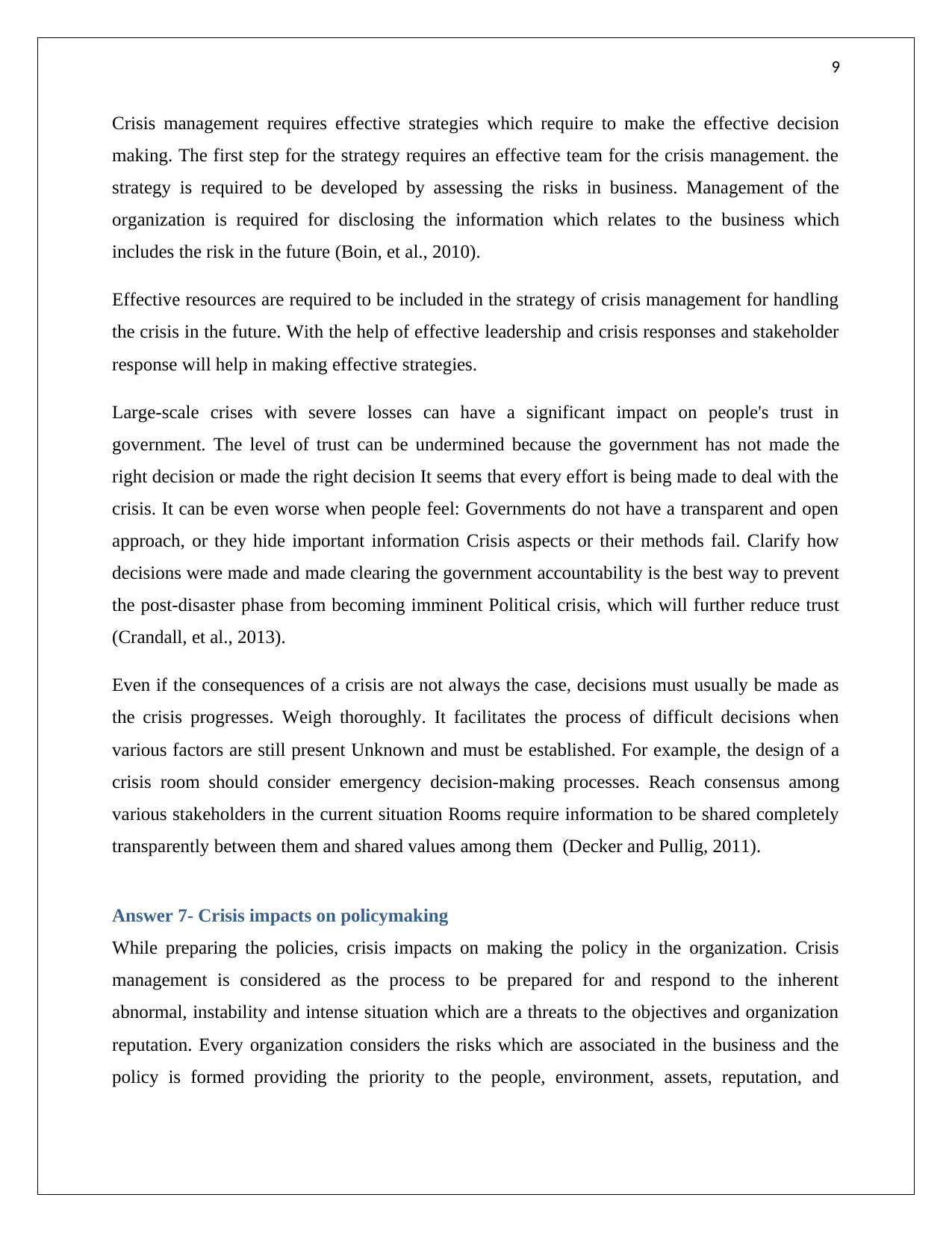
9
Crisis management requires effective strategies which require to make the effective decision
making. The first step for the strategy requires an effective team for the crisis management. the
strategy is required to be developed by assessing the risks in business. Management of the
organization is required for disclosing the information which relates to the business which
includes the risk in the future (Boin, et al., 2010).
Effective resources are required to be included in the strategy of crisis management for handling
the crisis in the future. With the help of effective leadership and crisis responses and stakeholder
response will help in making effective strategies.
Large-scale crises with severe losses can have a significant impact on people's trust in
government. The level of trust can be undermined because the government has not made the
right decision or made the right decision It seems that every effort is being made to deal with the
crisis. It can be even worse when people feel: Governments do not have a transparent and open
approach, or they hide important information Crisis aspects or their methods fail. Clarify how
decisions were made and made clearing the government accountability is the best way to prevent
the post-disaster phase from becoming imminent Political crisis, which will further reduce trust
(Crandall, et al., 2013).
Even if the consequences of a crisis are not always the case, decisions must usually be made as
the crisis progresses. Weigh thoroughly. It facilitates the process of difficult decisions when
various factors are still present Unknown and must be established. For example, the design of a
crisis room should consider emergency decision-making processes. Reach consensus among
various stakeholders in the current situation Rooms require information to be shared completely
transparently between them and shared values among them (Decker and Pullig, 2011).
Answer 7- Crisis impacts on policymaking
While preparing the policies, crisis impacts on making the policy in the organization. Crisis
management is considered as the process to be prepared for and respond to the inherent
abnormal, instability and intense situation which are a threats to the objectives and organization
reputation. Every organization considers the risks which are associated in the business and the
policy is formed providing the priority to the people, environment, assets, reputation, and
Crisis management requires effective strategies which require to make the effective decision
making. The first step for the strategy requires an effective team for the crisis management. the
strategy is required to be developed by assessing the risks in business. Management of the
organization is required for disclosing the information which relates to the business which
includes the risk in the future (Boin, et al., 2010).
Effective resources are required to be included in the strategy of crisis management for handling
the crisis in the future. With the help of effective leadership and crisis responses and stakeholder
response will help in making effective strategies.
Large-scale crises with severe losses can have a significant impact on people's trust in
government. The level of trust can be undermined because the government has not made the
right decision or made the right decision It seems that every effort is being made to deal with the
crisis. It can be even worse when people feel: Governments do not have a transparent and open
approach, or they hide important information Crisis aspects or their methods fail. Clarify how
decisions were made and made clearing the government accountability is the best way to prevent
the post-disaster phase from becoming imminent Political crisis, which will further reduce trust
(Crandall, et al., 2013).
Even if the consequences of a crisis are not always the case, decisions must usually be made as
the crisis progresses. Weigh thoroughly. It facilitates the process of difficult decisions when
various factors are still present Unknown and must be established. For example, the design of a
crisis room should consider emergency decision-making processes. Reach consensus among
various stakeholders in the current situation Rooms require information to be shared completely
transparently between them and shared values among them (Decker and Pullig, 2011).
Answer 7- Crisis impacts on policymaking
While preparing the policies, crisis impacts on making the policy in the organization. Crisis
management is considered as the process to be prepared for and respond to the inherent
abnormal, instability and intense situation which are a threats to the objectives and organization
reputation. Every organization considers the risks which are associated in the business and the
policy is formed providing the priority to the people, environment, assets, reputation, and
Secure Best Marks with AI Grader
Need help grading? Try our AI Grader for instant feedback on your assignments.
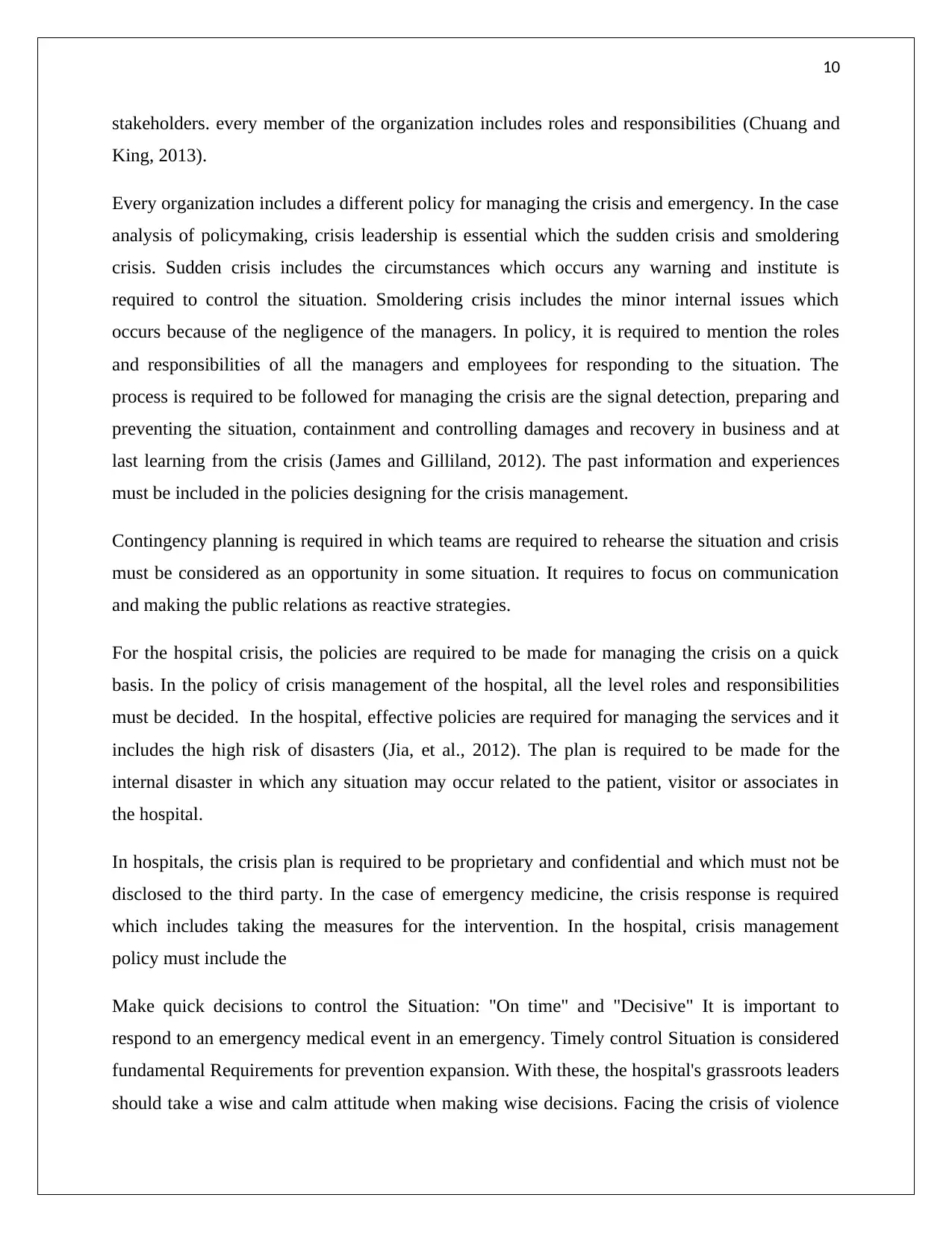
10
stakeholders. every member of the organization includes roles and responsibilities (Chuang and
King, 2013).
Every organization includes a different policy for managing the crisis and emergency. In the case
analysis of policymaking, crisis leadership is essential which the sudden crisis and smoldering
crisis. Sudden crisis includes the circumstances which occurs any warning and institute is
required to control the situation. Smoldering crisis includes the minor internal issues which
occurs because of the negligence of the managers. In policy, it is required to mention the roles
and responsibilities of all the managers and employees for responding to the situation. The
process is required to be followed for managing the crisis are the signal detection, preparing and
preventing the situation, containment and controlling damages and recovery in business and at
last learning from the crisis (James and Gilliland, 2012). The past information and experiences
must be included in the policies designing for the crisis management.
Contingency planning is required in which teams are required to rehearse the situation and crisis
must be considered as an opportunity in some situation. It requires to focus on communication
and making the public relations as reactive strategies.
For the hospital crisis, the policies are required to be made for managing the crisis on a quick
basis. In the policy of crisis management of the hospital, all the level roles and responsibilities
must be decided. In the hospital, effective policies are required for managing the services and it
includes the high risk of disasters (Jia, et al., 2012). The plan is required to be made for the
internal disaster in which any situation may occur related to the patient, visitor or associates in
the hospital.
In hospitals, the crisis plan is required to be proprietary and confidential and which must not be
disclosed to the third party. In the case of emergency medicine, the crisis response is required
which includes taking the measures for the intervention. In the hospital, crisis management
policy must include the
Make quick decisions to control the Situation: "On time" and "Decisive" It is important to
respond to an emergency medical event in an emergency. Timely control Situation is considered
fundamental Requirements for prevention expansion. With these, the hospital's grassroots leaders
should take a wise and calm attitude when making wise decisions. Facing the crisis of violence
stakeholders. every member of the organization includes roles and responsibilities (Chuang and
King, 2013).
Every organization includes a different policy for managing the crisis and emergency. In the case
analysis of policymaking, crisis leadership is essential which the sudden crisis and smoldering
crisis. Sudden crisis includes the circumstances which occurs any warning and institute is
required to control the situation. Smoldering crisis includes the minor internal issues which
occurs because of the negligence of the managers. In policy, it is required to mention the roles
and responsibilities of all the managers and employees for responding to the situation. The
process is required to be followed for managing the crisis are the signal detection, preparing and
preventing the situation, containment and controlling damages and recovery in business and at
last learning from the crisis (James and Gilliland, 2012). The past information and experiences
must be included in the policies designing for the crisis management.
Contingency planning is required in which teams are required to rehearse the situation and crisis
must be considered as an opportunity in some situation. It requires to focus on communication
and making the public relations as reactive strategies.
For the hospital crisis, the policies are required to be made for managing the crisis on a quick
basis. In the policy of crisis management of the hospital, all the level roles and responsibilities
must be decided. In the hospital, effective policies are required for managing the services and it
includes the high risk of disasters (Jia, et al., 2012). The plan is required to be made for the
internal disaster in which any situation may occur related to the patient, visitor or associates in
the hospital.
In hospitals, the crisis plan is required to be proprietary and confidential and which must not be
disclosed to the third party. In the case of emergency medicine, the crisis response is required
which includes taking the measures for the intervention. In the hospital, crisis management
policy must include the
Make quick decisions to control the Situation: "On time" and "Decisive" It is important to
respond to an emergency medical event in an emergency. Timely control Situation is considered
fundamental Requirements for prevention expansion. With these, the hospital's grassroots leaders
should take a wise and calm attitude when making wise decisions. Facing the crisis of violence
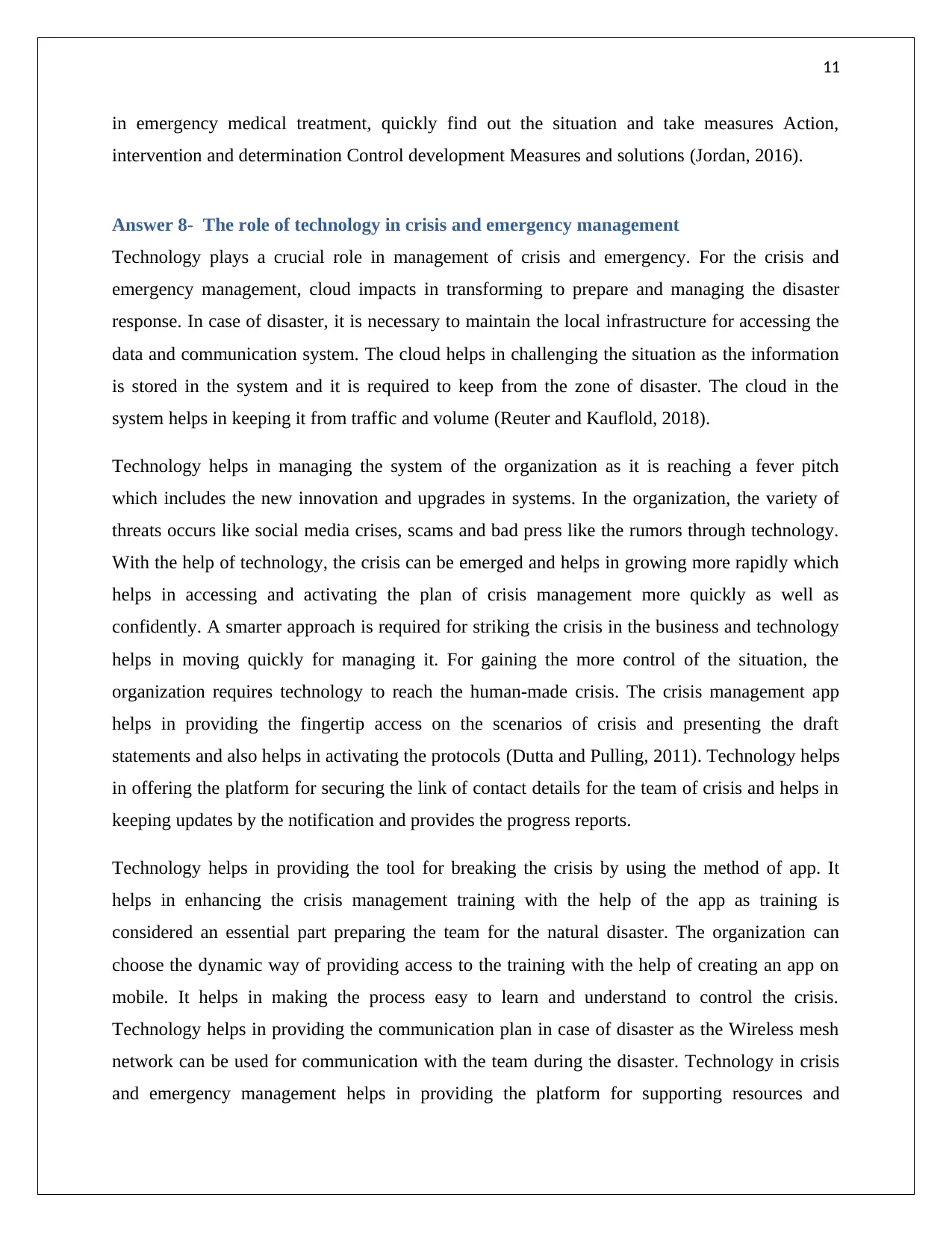
11
in emergency medical treatment, quickly find out the situation and take measures Action,
intervention and determination Control development Measures and solutions (Jordan, 2016).
Answer 8- The role of technology in crisis and emergency management
Technology plays a crucial role in management of crisis and emergency. For the crisis and
emergency management, cloud impacts in transforming to prepare and managing the disaster
response. In case of disaster, it is necessary to maintain the local infrastructure for accessing the
data and communication system. The cloud helps in challenging the situation as the information
is stored in the system and it is required to keep from the zone of disaster. The cloud in the
system helps in keeping it from traffic and volume (Reuter and Kauflold, 2018).
Technology helps in managing the system of the organization as it is reaching a fever pitch
which includes the new innovation and upgrades in systems. In the organization, the variety of
threats occurs like social media crises, scams and bad press like the rumors through technology.
With the help of technology, the crisis can be emerged and helps in growing more rapidly which
helps in accessing and activating the plan of crisis management more quickly as well as
confidently. A smarter approach is required for striking the crisis in the business and technology
helps in moving quickly for managing it. For gaining the more control of the situation, the
organization requires technology to reach the human-made crisis. The crisis management app
helps in providing the fingertip access on the scenarios of crisis and presenting the draft
statements and also helps in activating the protocols (Dutta and Pulling, 2011). Technology helps
in offering the platform for securing the link of contact details for the team of crisis and helps in
keeping updates by the notification and provides the progress reports.
Technology helps in providing the tool for breaking the crisis by using the method of app. It
helps in enhancing the crisis management training with the help of the app as training is
considered an essential part preparing the team for the natural disaster. The organization can
choose the dynamic way of providing access to the training with the help of creating an app on
mobile. It helps in making the process easy to learn and understand to control the crisis.
Technology helps in providing the communication plan in case of disaster as the Wireless mesh
network can be used for communication with the team during the disaster. Technology in crisis
and emergency management helps in providing the platform for supporting resources and
in emergency medical treatment, quickly find out the situation and take measures Action,
intervention and determination Control development Measures and solutions (Jordan, 2016).
Answer 8- The role of technology in crisis and emergency management
Technology plays a crucial role in management of crisis and emergency. For the crisis and
emergency management, cloud impacts in transforming to prepare and managing the disaster
response. In case of disaster, it is necessary to maintain the local infrastructure for accessing the
data and communication system. The cloud helps in challenging the situation as the information
is stored in the system and it is required to keep from the zone of disaster. The cloud in the
system helps in keeping it from traffic and volume (Reuter and Kauflold, 2018).
Technology helps in managing the system of the organization as it is reaching a fever pitch
which includes the new innovation and upgrades in systems. In the organization, the variety of
threats occurs like social media crises, scams and bad press like the rumors through technology.
With the help of technology, the crisis can be emerged and helps in growing more rapidly which
helps in accessing and activating the plan of crisis management more quickly as well as
confidently. A smarter approach is required for striking the crisis in the business and technology
helps in moving quickly for managing it. For gaining the more control of the situation, the
organization requires technology to reach the human-made crisis. The crisis management app
helps in providing the fingertip access on the scenarios of crisis and presenting the draft
statements and also helps in activating the protocols (Dutta and Pulling, 2011). Technology helps
in offering the platform for securing the link of contact details for the team of crisis and helps in
keeping updates by the notification and provides the progress reports.
Technology helps in providing the tool for breaking the crisis by using the method of app. It
helps in enhancing the crisis management training with the help of the app as training is
considered an essential part preparing the team for the natural disaster. The organization can
choose the dynamic way of providing access to the training with the help of creating an app on
mobile. It helps in making the process easy to learn and understand to control the crisis.
Technology helps in providing the communication plan in case of disaster as the Wireless mesh
network can be used for communication with the team during the disaster. Technology in crisis
and emergency management helps in providing the platform for supporting resources and
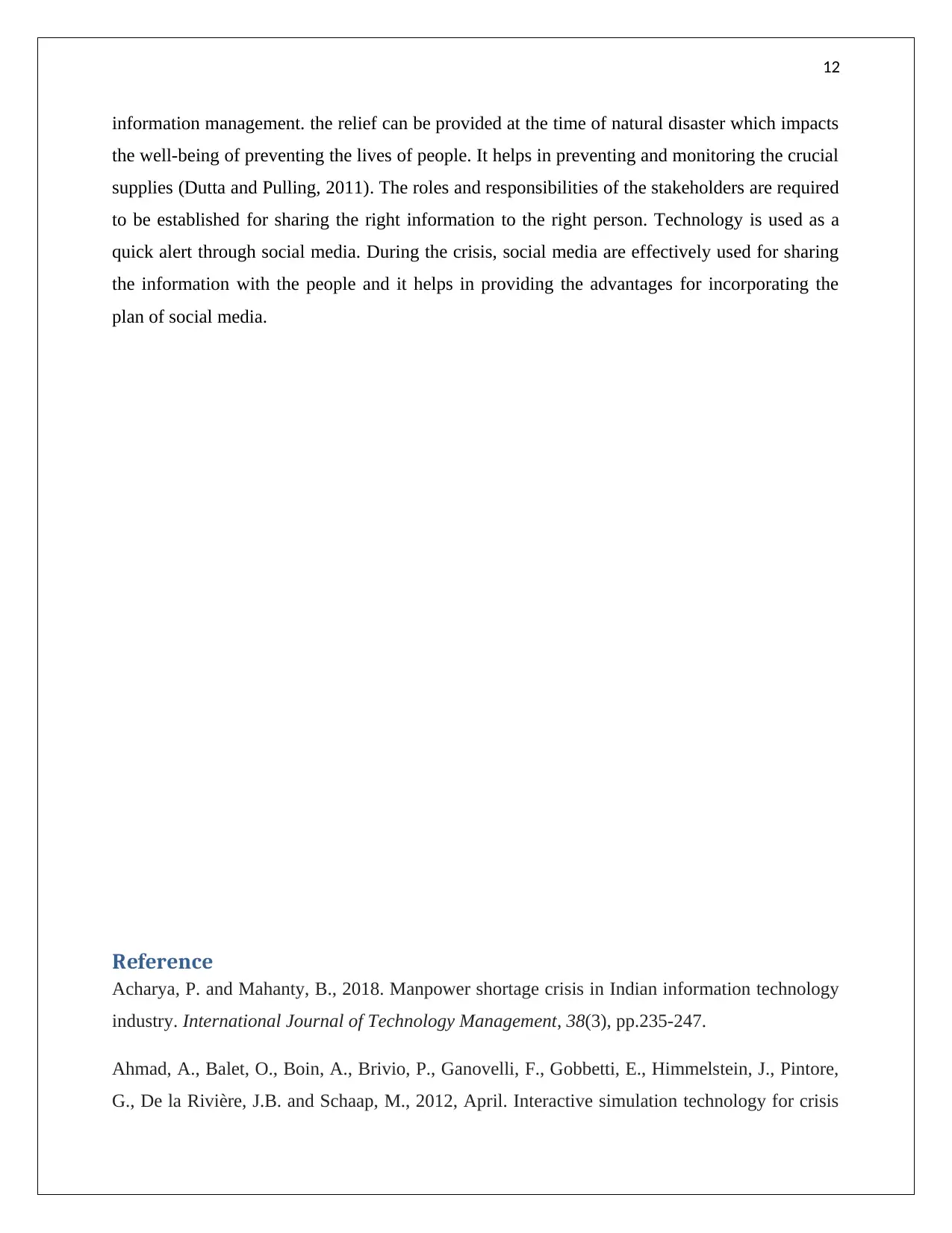
12
information management. the relief can be provided at the time of natural disaster which impacts
the well-being of preventing the lives of people. It helps in preventing and monitoring the crucial
supplies (Dutta and Pulling, 2011). The roles and responsibilities of the stakeholders are required
to be established for sharing the right information to the right person. Technology is used as a
quick alert through social media. During the crisis, social media are effectively used for sharing
the information with the people and it helps in providing the advantages for incorporating the
plan of social media.
Reference
Acharya, P. and Mahanty, B., 2018. Manpower shortage crisis in Indian information technology
industry. International Journal of Technology Management, 38(3), pp.235-247.
Ahmad, A., Balet, O., Boin, A., Brivio, P., Ganovelli, F., Gobbetti, E., Himmelstein, J., Pintore,
G., De la Rivière, J.B. and Schaap, M., 2012, April. Interactive simulation technology for crisis
information management. the relief can be provided at the time of natural disaster which impacts
the well-being of preventing the lives of people. It helps in preventing and monitoring the crucial
supplies (Dutta and Pulling, 2011). The roles and responsibilities of the stakeholders are required
to be established for sharing the right information to the right person. Technology is used as a
quick alert through social media. During the crisis, social media are effectively used for sharing
the information with the people and it helps in providing the advantages for incorporating the
plan of social media.
Reference
Acharya, P. and Mahanty, B., 2018. Manpower shortage crisis in Indian information technology
industry. International Journal of Technology Management, 38(3), pp.235-247.
Ahmad, A., Balet, O., Boin, A., Brivio, P., Ganovelli, F., Gobbetti, E., Himmelstein, J., Pintore,
G., De la Rivière, J.B. and Schaap, M., 2012, April. Interactive simulation technology for crisis
Paraphrase This Document
Need a fresh take? Get an instant paraphrase of this document with our AI Paraphraser
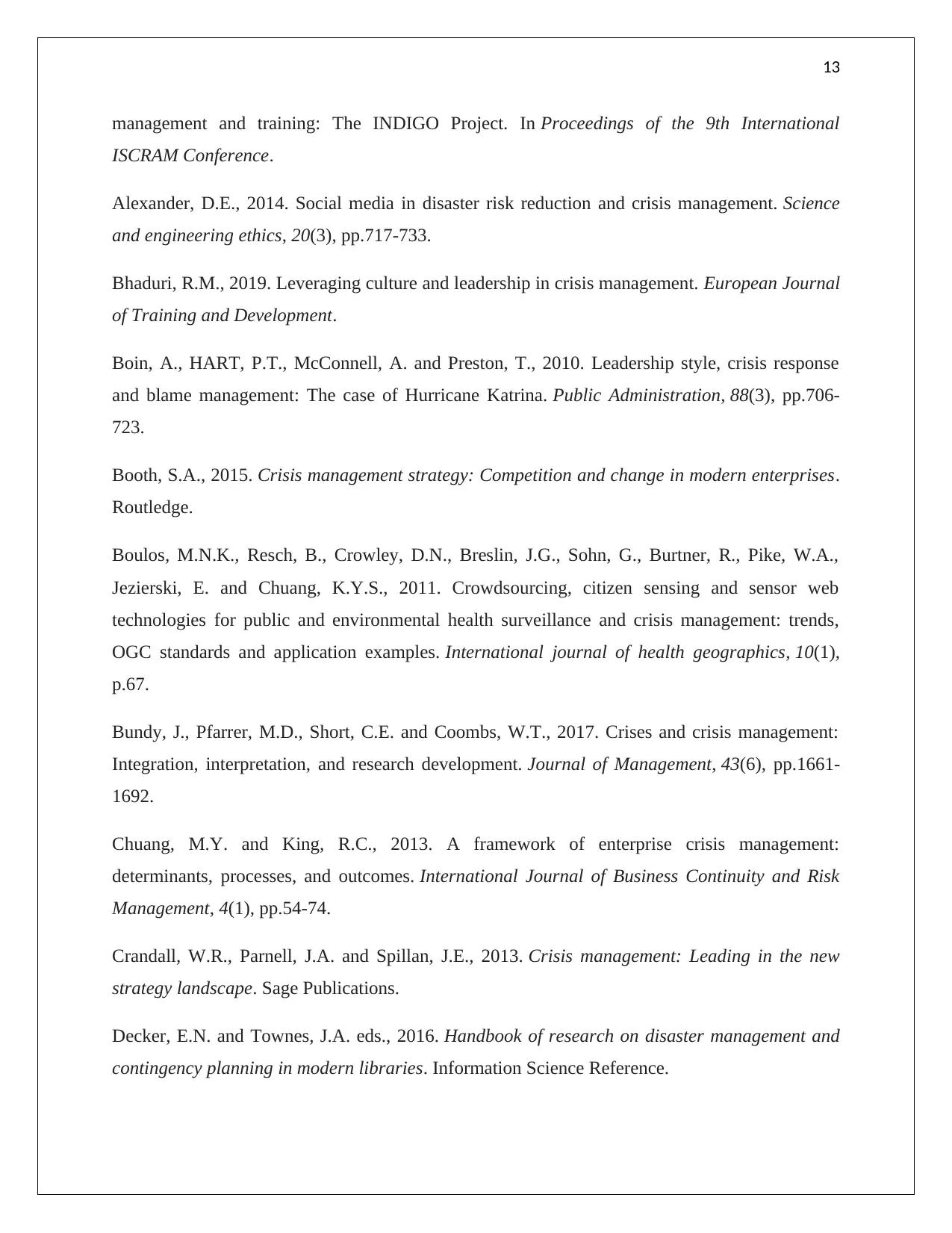
13
management and training: The INDIGO Project. In Proceedings of the 9th International
ISCRAM Conference.
Alexander, D.E., 2014. Social media in disaster risk reduction and crisis management. Science
and engineering ethics, 20(3), pp.717-733.
Bhaduri, R.M., 2019. Leveraging culture and leadership in crisis management. European Journal
of Training and Development.
Boin, A., HART, P.T., McConnell, A. and Preston, T., 2010. Leadership style, crisis response
and blame management: The case of Hurricane Katrina. Public Administration, 88(3), pp.706-
723.
Booth, S.A., 2015. Crisis management strategy: Competition and change in modern enterprises.
Routledge.
Boulos, M.N.K., Resch, B., Crowley, D.N., Breslin, J.G., Sohn, G., Burtner, R., Pike, W.A.,
Jezierski, E. and Chuang, K.Y.S., 2011. Crowdsourcing, citizen sensing and sensor web
technologies for public and environmental health surveillance and crisis management: trends,
OGC standards and application examples. International journal of health geographics, 10(1),
p.67.
Bundy, J., Pfarrer, M.D., Short, C.E. and Coombs, W.T., 2017. Crises and crisis management:
Integration, interpretation, and research development. Journal of Management, 43(6), pp.1661-
1692.
Chuang, M.Y. and King, R.C., 2013. A framework of enterprise crisis management:
determinants, processes, and outcomes. International Journal of Business Continuity and Risk
Management, 4(1), pp.54-74.
Crandall, W.R., Parnell, J.A. and Spillan, J.E., 2013. Crisis management: Leading in the new
strategy landscape. Sage Publications.
Decker, E.N. and Townes, J.A. eds., 2016. Handbook of research on disaster management and
contingency planning in modern libraries. Information Science Reference.
management and training: The INDIGO Project. In Proceedings of the 9th International
ISCRAM Conference.
Alexander, D.E., 2014. Social media in disaster risk reduction and crisis management. Science
and engineering ethics, 20(3), pp.717-733.
Bhaduri, R.M., 2019. Leveraging culture and leadership in crisis management. European Journal
of Training and Development.
Boin, A., HART, P.T., McConnell, A. and Preston, T., 2010. Leadership style, crisis response
and blame management: The case of Hurricane Katrina. Public Administration, 88(3), pp.706-
723.
Booth, S.A., 2015. Crisis management strategy: Competition and change in modern enterprises.
Routledge.
Boulos, M.N.K., Resch, B., Crowley, D.N., Breslin, J.G., Sohn, G., Burtner, R., Pike, W.A.,
Jezierski, E. and Chuang, K.Y.S., 2011. Crowdsourcing, citizen sensing and sensor web
technologies for public and environmental health surveillance and crisis management: trends,
OGC standards and application examples. International journal of health geographics, 10(1),
p.67.
Bundy, J., Pfarrer, M.D., Short, C.E. and Coombs, W.T., 2017. Crises and crisis management:
Integration, interpretation, and research development. Journal of Management, 43(6), pp.1661-
1692.
Chuang, M.Y. and King, R.C., 2013. A framework of enterprise crisis management:
determinants, processes, and outcomes. International Journal of Business Continuity and Risk
Management, 4(1), pp.54-74.
Crandall, W.R., Parnell, J.A. and Spillan, J.E., 2013. Crisis management: Leading in the new
strategy landscape. Sage Publications.
Decker, E.N. and Townes, J.A. eds., 2016. Handbook of research on disaster management and
contingency planning in modern libraries. Information Science Reference.
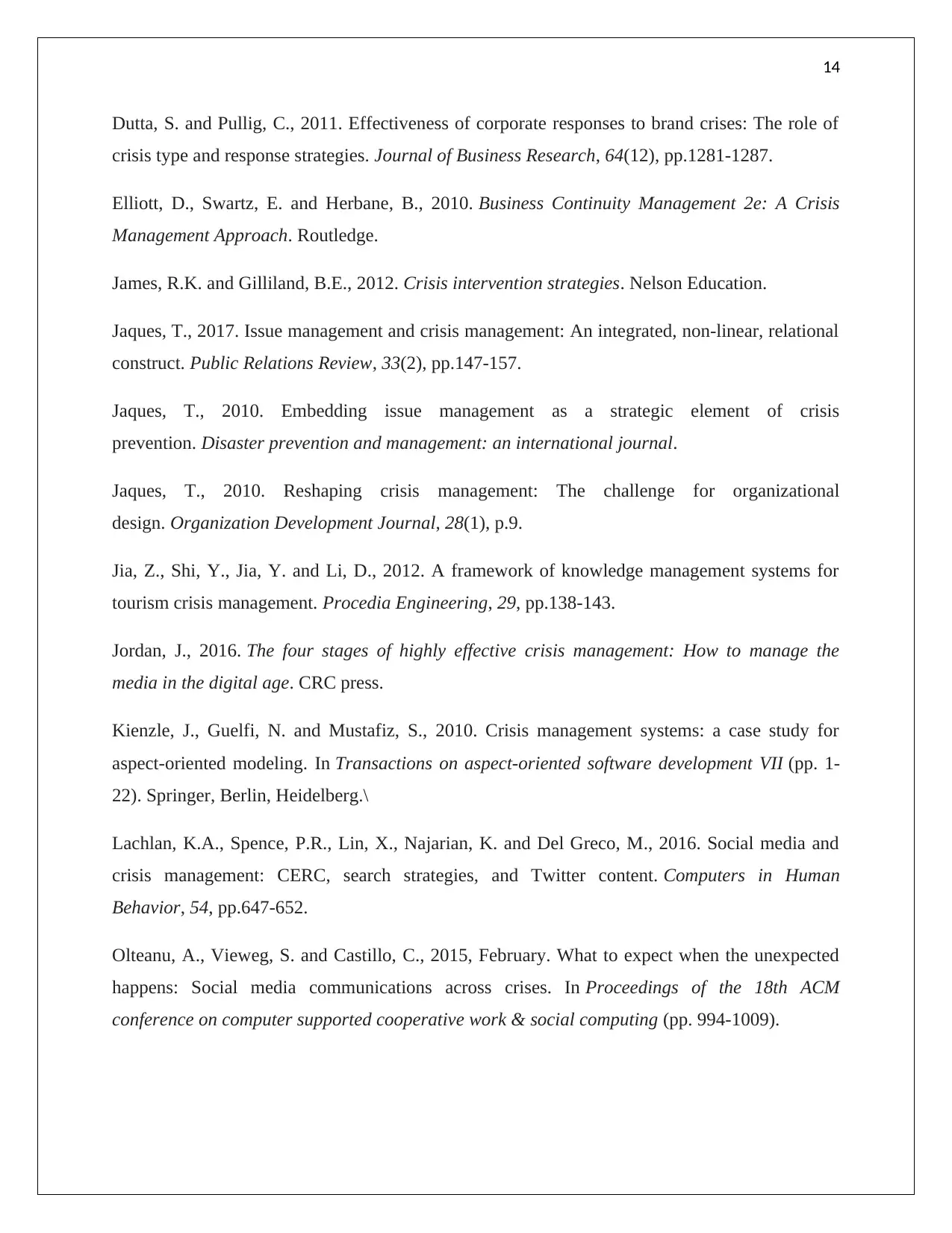
14
Dutta, S. and Pullig, C., 2011. Effectiveness of corporate responses to brand crises: The role of
crisis type and response strategies. Journal of Business Research, 64(12), pp.1281-1287.
Elliott, D., Swartz, E. and Herbane, B., 2010. Business Continuity Management 2e: A Crisis
Management Approach. Routledge.
James, R.K. and Gilliland, B.E., 2012. Crisis intervention strategies. Nelson Education.
Jaques, T., 2017. Issue management and crisis management: An integrated, non-linear, relational
construct. Public Relations Review, 33(2), pp.147-157.
Jaques, T., 2010. Embedding issue management as a strategic element of crisis
prevention. Disaster prevention and management: an international journal.
Jaques, T., 2010. Reshaping crisis management: The challenge for organizational
design. Organization Development Journal, 28(1), p.9.
Jia, Z., Shi, Y., Jia, Y. and Li, D., 2012. A framework of knowledge management systems for
tourism crisis management. Procedia Engineering, 29, pp.138-143.
Jordan, J., 2016. The four stages of highly effective crisis management: How to manage the
media in the digital age. CRC press.
Kienzle, J., Guelfi, N. and Mustafiz, S., 2010. Crisis management systems: a case study for
aspect-oriented modeling. In Transactions on aspect-oriented software development VII (pp. 1-
22). Springer, Berlin, Heidelberg.\
Lachlan, K.A., Spence, P.R., Lin, X., Najarian, K. and Del Greco, M., 2016. Social media and
crisis management: CERC, search strategies, and Twitter content. Computers in Human
Behavior, 54, pp.647-652.
Olteanu, A., Vieweg, S. and Castillo, C., 2015, February. What to expect when the unexpected
happens: Social media communications across crises. In Proceedings of the 18th ACM
conference on computer supported cooperative work & social computing (pp. 994-1009).
Dutta, S. and Pullig, C., 2011. Effectiveness of corporate responses to brand crises: The role of
crisis type and response strategies. Journal of Business Research, 64(12), pp.1281-1287.
Elliott, D., Swartz, E. and Herbane, B., 2010. Business Continuity Management 2e: A Crisis
Management Approach. Routledge.
James, R.K. and Gilliland, B.E., 2012. Crisis intervention strategies. Nelson Education.
Jaques, T., 2017. Issue management and crisis management: An integrated, non-linear, relational
construct. Public Relations Review, 33(2), pp.147-157.
Jaques, T., 2010. Embedding issue management as a strategic element of crisis
prevention. Disaster prevention and management: an international journal.
Jaques, T., 2010. Reshaping crisis management: The challenge for organizational
design. Organization Development Journal, 28(1), p.9.
Jia, Z., Shi, Y., Jia, Y. and Li, D., 2012. A framework of knowledge management systems for
tourism crisis management. Procedia Engineering, 29, pp.138-143.
Jordan, J., 2016. The four stages of highly effective crisis management: How to manage the
media in the digital age. CRC press.
Kienzle, J., Guelfi, N. and Mustafiz, S., 2010. Crisis management systems: a case study for
aspect-oriented modeling. In Transactions on aspect-oriented software development VII (pp. 1-
22). Springer, Berlin, Heidelberg.\
Lachlan, K.A., Spence, P.R., Lin, X., Najarian, K. and Del Greco, M., 2016. Social media and
crisis management: CERC, search strategies, and Twitter content. Computers in Human
Behavior, 54, pp.647-652.
Olteanu, A., Vieweg, S. and Castillo, C., 2015, February. What to expect when the unexpected
happens: Social media communications across crises. In Proceedings of the 18th ACM
conference on computer supported cooperative work & social computing (pp. 994-1009).
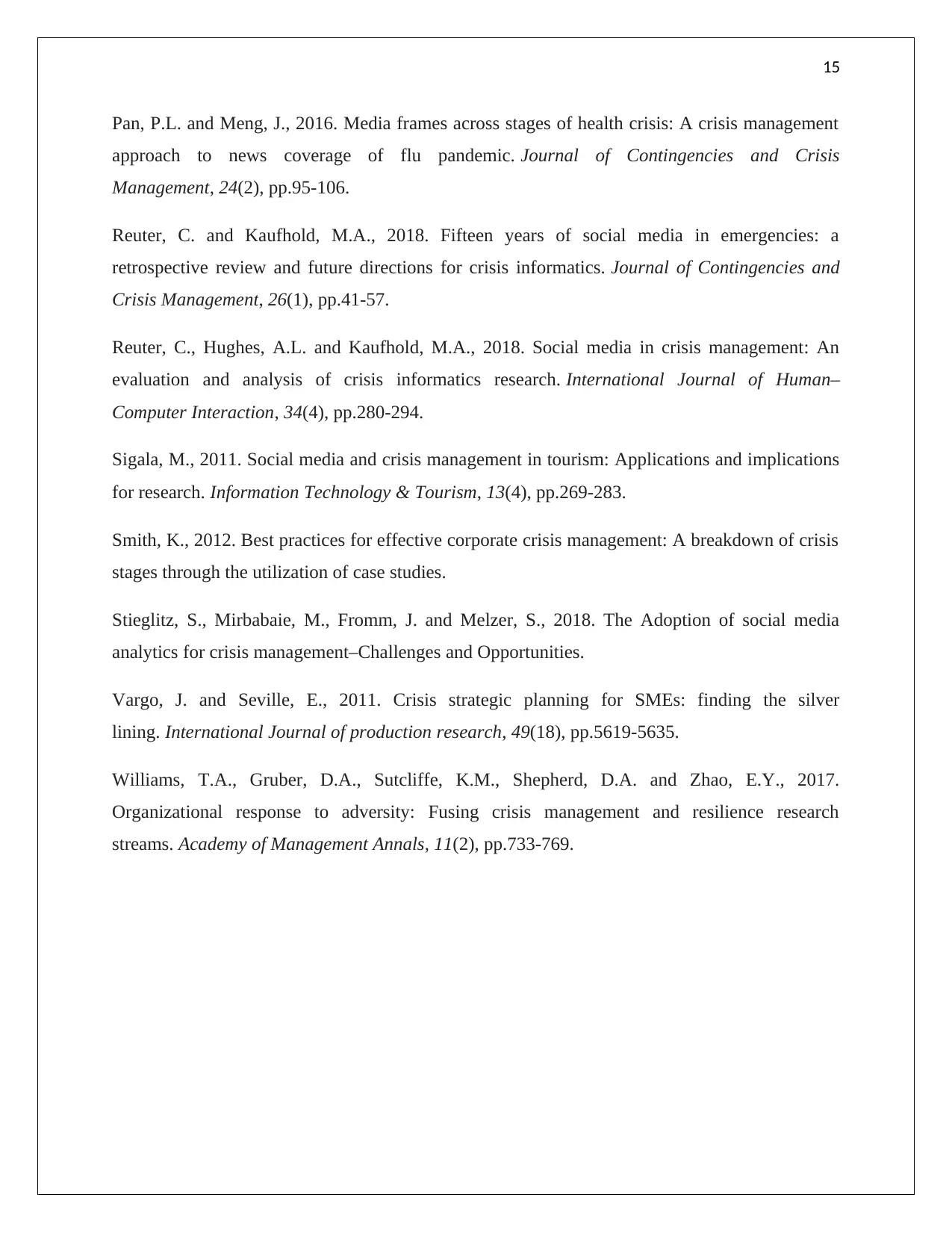
15
Pan, P.L. and Meng, J., 2016. Media frames across stages of health crisis: A crisis management
approach to news coverage of flu pandemic. Journal of Contingencies and Crisis
Management, 24(2), pp.95-106.
Reuter, C. and Kaufhold, M.A., 2018. Fifteen years of social media in emergencies: a
retrospective review and future directions for crisis informatics. Journal of Contingencies and
Crisis Management, 26(1), pp.41-57.
Reuter, C., Hughes, A.L. and Kaufhold, M.A., 2018. Social media in crisis management: An
evaluation and analysis of crisis informatics research. International Journal of Human–
Computer Interaction, 34(4), pp.280-294.
Sigala, M., 2011. Social media and crisis management in tourism: Applications and implications
for research. Information Technology & Tourism, 13(4), pp.269-283.
Smith, K., 2012. Best practices for effective corporate crisis management: A breakdown of crisis
stages through the utilization of case studies.
Stieglitz, S., Mirbabaie, M., Fromm, J. and Melzer, S., 2018. The Adoption of social media
analytics for crisis management–Challenges and Opportunities.
Vargo, J. and Seville, E., 2011. Crisis strategic planning for SMEs: finding the silver
lining. International Journal of production research, 49(18), pp.5619-5635.
Williams, T.A., Gruber, D.A., Sutcliffe, K.M., Shepherd, D.A. and Zhao, E.Y., 2017.
Organizational response to adversity: Fusing crisis management and resilience research
streams. Academy of Management Annals, 11(2), pp.733-769.
Pan, P.L. and Meng, J., 2016. Media frames across stages of health crisis: A crisis management
approach to news coverage of flu pandemic. Journal of Contingencies and Crisis
Management, 24(2), pp.95-106.
Reuter, C. and Kaufhold, M.A., 2018. Fifteen years of social media in emergencies: a
retrospective review and future directions for crisis informatics. Journal of Contingencies and
Crisis Management, 26(1), pp.41-57.
Reuter, C., Hughes, A.L. and Kaufhold, M.A., 2018. Social media in crisis management: An
evaluation and analysis of crisis informatics research. International Journal of Human–
Computer Interaction, 34(4), pp.280-294.
Sigala, M., 2011. Social media and crisis management in tourism: Applications and implications
for research. Information Technology & Tourism, 13(4), pp.269-283.
Smith, K., 2012. Best practices for effective corporate crisis management: A breakdown of crisis
stages through the utilization of case studies.
Stieglitz, S., Mirbabaie, M., Fromm, J. and Melzer, S., 2018. The Adoption of social media
analytics for crisis management–Challenges and Opportunities.
Vargo, J. and Seville, E., 2011. Crisis strategic planning for SMEs: finding the silver
lining. International Journal of production research, 49(18), pp.5619-5635.
Williams, T.A., Gruber, D.A., Sutcliffe, K.M., Shepherd, D.A. and Zhao, E.Y., 2017.
Organizational response to adversity: Fusing crisis management and resilience research
streams. Academy of Management Annals, 11(2), pp.733-769.
1 out of 16
Related Documents
Your All-in-One AI-Powered Toolkit for Academic Success.
+13062052269
info@desklib.com
Available 24*7 on WhatsApp / Email
![[object Object]](/_next/static/media/star-bottom.7253800d.svg)
Unlock your academic potential
© 2024 | Zucol Services PVT LTD | All rights reserved.





